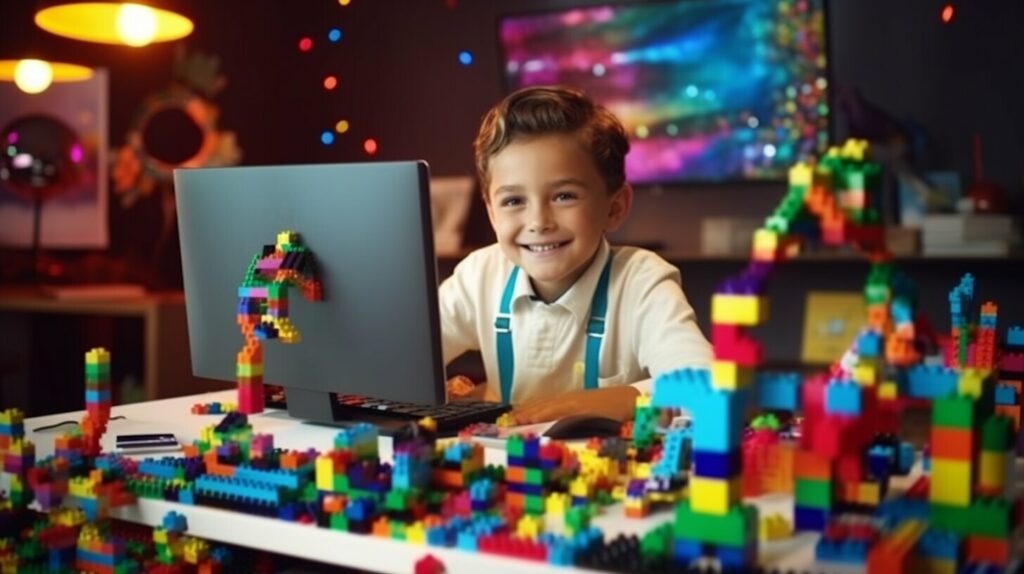Introducing computer science to children can be challenging, but it doesn’t have to be. With the right approach, you can make it fun, engaging, and accessible. In this section, we’ll show you how to explain computer science to a child in a way that makes sense to them. You’ll learn techniques that will help you simplify complex concepts and spark their interest in technology.
Before we dive in, it’s important to understand that computer science isn’t just about coding and programming. It encompasses a wide range of topics, including but not limited to cybersecurity, data analysis, and artificial intelligence. By introducing these concepts early on, you can help your child develop a deeper understanding of the technology that surrounds them.
Key Takeaways:
- Explaining computer science to a child requires a fun and engaging approach
- Computer science encompasses a wide range of topics beyond just coding and programming
- Introducing these concepts early on can help children develop a deeper understanding of technology
Why Teach Computer Science to Children?
Teaching computer science to children has become increasingly important in today’s digital age. By introducing computer science concepts early on, children can develop essential skills that are highly valued in today’s workforce.
Computer science education can enhance problem-solving skills, critical thinking, and creativity. As children learn the fundamentals of coding and programming, they also develop logical thinking and the ability to analyze and solve complex problems.

Moreover, computer science education can prepare children for future job opportunities. As technology continues to shape our daily lives, the demand for computer science professionals is on the rise. Teaching computer science to children can help them become competitive in a rapidly evolving job market.
Overall, teaching computer science to children can unlock their potential and provide them with valuable life skills. By making computer science education accessible and fun, we can inspire children to pursue their interests and potentially even make a difference in the world.
Introducing Technology to Kids
Introducing technology to kids is an essential step towards helping them understand basic computer science concepts. While some parents may feel hesitant, age-appropriate gadgets and activities can be a great introduction to the world of technology. By making technology a regular part of their lives, children can become familiar with it and feel comfortable using it.
Here are a few examples of age-appropriate gadgets and activities that can introduce basic computer science concepts:
| Gadget/Activity | Age Range |
|---|---|
| Interactive Storybooks | 2-4 years old |
| Programming Toys | 4-8 years old |
| Basic Coding Games | 6-10 years old |
| STEM Kits | 8-12 years old |
Using gadgets and activities that are age-appropriate helps keep kids engaged and interested. It’s important to look for activities that are fun and interactive – the more hands-on the better! By trying out different gadgets and activities, kids can gain exposure to technology and learn basic principles of computer science in a fun and playful way.

Remember, it’s never too early to start introducing technology to kids. By incorporating gadgets and activities that encourage exploration and learning, parents can help their children develop a lifelong interest in computer science.
How to Explain Coding to a Child
Explaining coding to a child can seem daunting, but it doesn’t have to be. Here are some tips to make it easy and fun.
Start with the basics
Begin by explaining what coding is and why it’s important. Put simply, coding is a set of instructions that tell a computer what to do. It’s what makes the apps, websites, and games we use every day possible.
Use simple analogies to explain concepts like variables, loops, and functions. For example, compare variables to containers that hold information, or compare loops to a recipe that you follow step by step.

Use interactive games and exercises
Make coding fun and interactive by using games and exercises. There are many coding apps and websites designed for children that use playful graphics and characters to teach coding concepts.
Encourage children to experiment and explore coding on their own. Give them simple challenges to solve, such as creating a simple animation or a game.
Emphasize creativity
Coding is not just about logic and problem-solving; it’s also a creative process. Encourage children to express their creativity by designing their own websites, games, or apps.
Show them examples of creative coding projects, such as interactive art installations or music apps. Let them know that coding can be a powerful tool for creating things that they are passionate about.
Engaging Activities for Teaching Computer Science
If you want to make computer science education fun and interactive for your child, consider the following engaging activities:
- Coding games: There are many online and offline coding games available that make learning to code a fun and interactive experience. Some popular examples include Code.org, Scratch, and CodeCombat.
- Puzzles: Puzzles are a great way to teach children problem-solving skills and logical thinking. Consider using hands-on puzzles like Tangrams or classic board games like chess or checkers.
- Hands-on experiments: Hands-on experiments can help children understand complex computer science concepts. You can create simple experiments like making a robot or a simple circuit.

By incorporating these fun and engaging activities into your child’s learning experience, you can help them develop a love for computer science and coding. Encourage your child to explore these activities and try new things!
Using Real-Life Examples in Computer Science Education
Computer science concepts can be abstract and difficult for children to grasp. One effective strategy for teaching these concepts is by incorporating real-life examples. By relating computer science to everyday situations, children can better understand the relevance and practical applications of computer science.
For example, when teaching about loops, you can compare it to brushing your teeth. Just as you brush your teeth repeatedly to clean them, loops in programming repeat certain actions. By using relatable examples, you can make computer science more accessible and interesting for children.
| Real-Life Example | Related Concept |
|---|---|
| Ordering food at a restaurant | Sequential logic |
| Following a recipe | Algorithms |
| Building with Legos | Problem-solving |
Real-life examples can also help children relate to more complex concepts, such as artificial intelligence and machine learning. You can explain how a GPS system provides directions by using algorithms and data. Or how voice assistants like Siri and Alexa use machine learning to recognize and respond to your voice.

By adding real-life examples to your computer science curriculum, you can make learning more engaging and relevant to children. Encourage them to think of their own examples or situations where they can apply computer science concepts. This will help them develop a deeper understanding of computer science and its various applications.
Building Problem-Solving Skills through Computer Science
Teaching computer science to children can enhance their problem-solving skills. By applying computer science principles, children can learn valuable problem-solving techniques. Here are some strategies and exercises that can help:
- Logic puzzles: Encourage children to solve logic puzzles to develop their ability to reason and think logically.
- Coding challenges: Provide challenges that require children to use their coding skills to solve problems and complete tasks.
- Real-world problem-solving: Have children come up with solutions to real-world problems using computer science concepts and logic.
By using these strategies, children can develop critical thinking skills that are valuable in many areas of life, not just computer science. Remember, the ultimate goal of teaching computer science to children is to enable them to use their knowledge to solve problems and make the world a better place.

Fostering Creativity in Computer Science Education
Computer science education is not just about coding and programming; it can also foster creativity! By learning computer science concepts, children can express their creativity by developing digital projects, such as games and animations. In fact, coding can be seen as a form of digital art.
Encourage your child to experiment with code and develop their own projects. For example, they could create a game or animation using Scratch, a free visual programming language designed for children. Alternatively, they could use a website builder to create their own website.
By allowing children to explore and express themselves through coding, they can find joy and passion in computer science. Who knows, your child may even develop the next big app or game!

Encouraging creativity in computer science education can open up a world of possibilities for children. By using code to develop their own projects, they can express their unique ideas and perspectives in a digital format.
Overcoming Challenges in Teaching Computer Science
Teaching computer science to children can be a challenging task, but with the right approach, it can be an enjoyable and rewarding experience for both educators and learners.
One of the main challenges is making programming accessible and interesting to children with different learning styles. Some children might prefer hands-on activities, while others might enjoy visual aids or interactive games. To overcome this challenge, consider incorporating various teaching methods and tools that cater to diverse learning preferences. For instance, you can use videos, animations, or presentations to explain complex concepts, or provide hands-on exercises to allow tactile learners to explore coding.
Another common difficulty is dealing with children’s frustration and confusion when learning to code. Programming can be confusing and challenging, even for adults, and children might easily get discouraged if they encounter obstacles. To help children overcome these challenges, show them that making mistakes is a natural part of the learning process. Encourage them to ask questions, seek help, and collaborate with peers, and celebrate their progress and achievements.
Lastly, some parents and educators might feel intimidated by the subject matter, particularly if they have limited experience in computer science. However, overcoming this challenge is possible by investing time in self-education and seeking professional guidance. Attend workshops and training sessions, read online resources and books, and connect with other educators to exchange ideas and best practices.
Remember, teaching computer science to children is a collaborative effort that requires enthusiasm, patience, and an open mindset. By continuing to learn and adapt your teaching methods, you can create a supportive and inclusive learning environment that fosters children’s interest in programming.

Celebrating Achievements and Progress
Recognizing a child’s achievements and progress in computer science is essential to motivate and encourage them to continue learning. Celebrating their accomplishments can boost their self-esteem and confidence, leading to a positive attitude towards learning. There are various ways to celebrate their progress in computer science education, including:
| Method | Description |
|---|---|
| Certificates | Rewarding children with certificates for completing coding challenges or courses. These certificates can be printed out and displayed at home or school. |
| Badges | Similar to certificates, badges can be awarded to children for achieving specific goals or milestones. These badges can be digital or physical and can be displayed on their profile or backpack. |
| Competitions | Encouraging children to participate in coding competitions can motivate them to practice and improve their skills. These competitions can be local or online and can include challenges or hackathons. |
Celebrations do not have to be grand or expensive. A simple recognition of the child’s efforts and progress can make a significant impact on their learning journey.

Remember, every child learns at their own pace and has their own strengths and weaknesses. Celebrating progress and achievements can help children feel valued and appreciated for their hard work, regardless of their skill level.
Engaging with the Computer Science Community
If you want to nurture your child’s interest in computer science, it’s important to engage with the community. There are many ways your child can connect with like-minded peers and mentors who share their passion for technology. Here are some suggestions to get you started:
- Join a coding club: Many schools and libraries offer after-school coding clubs where children can learn from experienced mentors and collaborate with their peers on projects.
- Participate in online communities: There are many online forums and communities dedicated to computer science education for kids. Your child can connect with other young programmers, share their projects, and ask for advice from more experienced coders.
- Attend workshops and hackathons: Various organizations offer workshops and hackathons that give children the opportunity to apply their computer science skills to real-world challenges and create innovative solutions.
By participating in these activities, your child can gain valuable experience, build a network of peers and mentors, and stay up-to-date with the latest trends and developments in the field. They may even discover new interests and career opportunities that they never knew existed!
Encourage your child to explore these opportunities and engage with the computer science community. Who knows what they may create or discover!

Conclusion
Congratulations! You have learned some valuable tips and strategies for explaining computer science to children. By making computer science education fun, engaging, and accessible, you can help your child develop critical thinking, problem-solving skills, and creativity.
Remember the importance of introducing technology to children at an early age and using real-life examples to make computer science concepts more relatable. Engaging activities, such as coding games and puzzles, can also make learning more enjoyable.
Keep Learning and Celebrating Achievements
As your child progresses in computer science education, don’t forget to celebrate their achievements and progress. Recognizing their efforts through certificates, badges, or competitions can help motivate and encourage them to continue exploring computer science.
Engaging with the computer science community, such as through coding clubs and online communities, is also a great way to connect with others who share your child’s interests.
Overcoming Challenges
While teaching computer science to children may present some challenges, it’s important to address them proactively and create a supportive learning environment. Remember to use age-appropriate language, simplify complex concepts, and provide plenty of encouragement and positive feedback.
By following these tips and strategies, you can successfully explain computer science to children and nurture their interest in this exciting field!
Can the Same Tips be Used to Explain Paradox to a Child?
Explaining paradox to children may seem challenging, but with simple tips to explain paradox, it can become easier. Encourage critical thinking by using relatable examples or stories. Illustrate how things can be true yet contradictory, helping them grasp the concept gradually. Simplifying complex terms and engaging their curiosity can make paradoxes understandable for children.
FAQ
Q: How can I explain computer science to my child in a fun and easy way?
A: To explain computer science to your child in a fun and easy way, you can use interactive games, puzzles, and hands-on experiments. By relating computer science concepts to everyday situations, you can make it more relatable and understandable for your child.
Q: Why is it important to teach computer science to children?
A: Teaching computer science to children is important because it can enhance problem-solving skills, critical thinking, and creativity. It can also introduce them to basic computer science concepts and foster their curiosity and familiarity with technology.
Q: How can I introduce technology to my kids at an early age?
A: You can introduce technology to your kids at an early age by providing age-appropriate gadgets and activities that introduce basic computer science concepts. This can help pique their curiosity and familiarity with technology.
Q: How can I explain coding to my child?
A: To explain coding to your child, you can simplify coding concepts and use interactive games and exercises. By making coding fun and easy to understand, your child can develop an interest in programming.
Q: What are some engaging activities for teaching computer science to children?
A: Some engaging activities for teaching computer science to children include coding games, puzzles, and hands-on experiments. By making learning interactive and enjoyable, children can develop a deeper understanding of computer science.
Q: How can I use real-life examples in computer science education?
A: You can use real-life examples in computer science education by relating computer science concepts to everyday situations. By doing so, children can better understand the relevance and practical applications of computer science.
Q: How can teaching computer science enhance a child’s problem-solving skills?
A: Teaching computer science can enhance a child’s problem-solving skills by developing logical thinking and problem-solving abilities. Different strategies and exercises can be used to apply computer science principles and teach valuable problem-solving techniques.
Q: How can computer science education foster creativity in children?
A: Computer science education can foster creativity in children by allowing them to express their creativity through coding and programming. They can develop games, animations, and other digital projects, nurturing their creativity and passion for computer science.
Q: What are some common challenges in teaching computer science to children?
A: Common challenges in teaching computer science to children include overcoming technical difficulties, adapting to different learning styles, and creating an inclusive and supportive learning environment. Practical tips can help educators and parents overcome these challenges and ensure a positive learning experience.
Q: Why is it important to celebrate children’s achievements and progress in computer science?
A: Celebrating children’s achievements and progress in computer science is important because it motivates and encourages them to continue exploring the field. Recognition through certificates, badges, or competitions can boost their confidence and passion for computer science.
Q: How can children engage with the computer science community?
A: Children can engage with the computer science community by participating in coding clubs, workshops, and online communities. By connecting with others who share their interests, they can build a network of support and inspiration.






